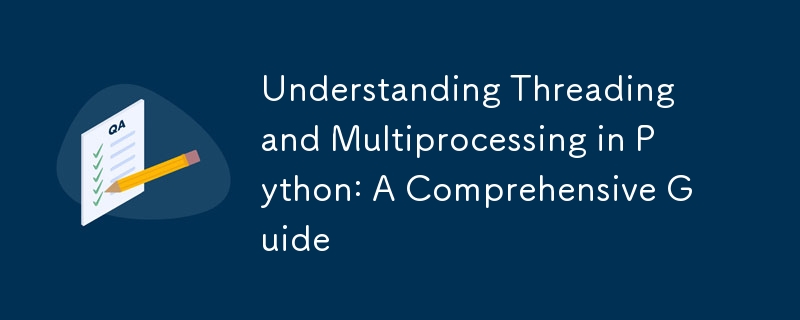

In Python, the concepts of threading and multiprocessing are often discussed when optimizing applications for performance, especially when they involve concurrent or parallel execution. Despite the overlap in terminology, these two approaches are fundamentally different.
This blog will help clarify the confusion around threading and multiprocessing, explain when to use each, and provide relevant examples for each concept.
Before diving into examples and use cases, let's outline the main differences:
Threading: Refers to running multiple threads (smaller units of a process) within a single process. Threads share the same memory space, which makes them lightweight. However, Python's Global Interpreter Lock (GIL) limits the true parallelism of threading for CPU-bound tasks.
Multiprocessing: Involves running multiple processes, each with its own memory space. Processes are heavier than threads but can achieve true parallelism because they do not share memory. This approach is ideal for CPU-bound tasks where full core utilization is needed.
Threading is a way to run multiple tasks concurrently within the same process. These tasks are handled by threads, which are separate, lightweight units of execution that share the same memory space. Threading is beneficial for I/O-bound operations, such as file reading, network requests, or database queries, where the main program spends a lot of time waiting for external resources.
import threading
import time
def print_numbers():
for i in range(5):
print(i)
time.sleep(1)
def print_letters():
for letter in ['a', 'b', 'c', 'd', 'e']:
print(letter)
time.sleep(1)
# Create two threads
t1 = threading.Thread(target=print_numbers)
t2 = threading.Thread(target=print_letters)
# Start both threads
t1.start()
t2.start()
# Wait for both threads to complete
t1.join()
t2.join()
print("Both threads finished execution.")
In the above example, two threads run concurrently: one prints numbers, and the other prints letters. The sleep() calls simulate I/O operations, and the program can switch between threads during these waits.
Python's GIL is a mechanism that prevents multiple native threads from executing Python bytecodes simultaneously. It ensures that only one thread runs at a time, even if multiple threads are active in the process.
This limitation makes threading unsuitable for CPU-bound tasks that need real parallelism because threads can't fully utilize multiple cores due to the GIL.
Multiprocessing allows you to run multiple processes simultaneously, where each process has its own memory space. Since processes don't share memory, there's no GIL restriction, allowing true parallel execution on multiple CPU cores. Multiprocessing is ideal for CPU-bound tasks that need to maximize CPU usage.
import multiprocessing
import time
def print_numbers():
for i in range(5):
print(i)
time.sleep(1)
def print_letters():
for letter in ['a', 'b', 'c', 'd', 'e']:
print(letter)
time.sleep(1)
if __name__ == "__main__":
# Create two processes
p1 = multiprocessing.Process(target=print_numbers)
p2 = multiprocessing.Process(target=print_letters)
# Start both processes
p1.start()
p2.start()
# Wait for both processes to complete
p1.join()
p2.join()
print("Both processes finished execution.")
In this example, two separate processes run concurrently. Unlike threads, each process has its own memory space, and they execute independently without interference from the GIL.
One key difference between threading and multiprocessing is that processes do not share memory. While this ensures there is no interference between processes, it also means that sharing data between them requires special mechanisms, such as Queue, Pipe, or Manager objects provided by the multiprocessing module.
Now that we understand how both approaches work, let's break down when to choose threading or multiprocessing based on the type of tasks:
| Use Case | Type | Why? |
|---|---|---|
| Network requests, I/O-bound tasks (file read/write, DB calls) | Threading | Multiple threads can handle I/O waits concurrently. |
| CPU-bound tasks (data processing, calculations) | Multiprocessing | True parallelism is possible by utilizing multiple cores. |
| Task requires shared memory or lightweight concurrency | Threading | Threads share memory and are cheaper in terms of resources. |
| Independent tasks needing complete isolation (e.g., separate processes) | Multiprocessing | Processes have isolated memory, making them safer for independent tasks. |
Threading excels in scenarios where the program waits on external resources (disk I/O, network). Since threads can work concurrently during these wait times, threading can help boost performance.
However, due to the GIL, CPU-bound tasks do not benefit much from threading because only one thread can execute at a time.
Multiprocessing allows true parallelism by running multiple processes across different CPU cores. Each process runs in its own memory space, bypassing the GIL and making it ideal for CPU-bound tasks.
However, creating processes is more resource-intensive than creating threads, and inter-process communication can slow things down if there's a lot of data sharing between processes.
Let's compare threading and multiprocessing for a CPU-bound task like calculating the sum of squares for a large list.
import threading
def calculate_squares(numbers):
result = sum([n * n for n in numbers])
print(result)
numbers = range(1, 10000000)
t1 = threading.Thread(target=calculate_squares, args=(numbers,))
t2 = threading.Thread(target=calculate_squares, args=(numbers,))
t1.start()
t2.start()
t1.join()
t2.join()
Due to the GIL, this example will not see significant performance improvements over a single-threaded version because the threads can't run simultaneously for CPU-bound operations.
import multiprocessing
def calculate_squares(numbers):
result = sum([n * n for n in numbers])
print(result)
if __name__ == "__main__":
numbers = range(1, 10000000)
p1 = multiprocessing.Process(target=calculate_squares, args=(numbers,))
p2 = multiprocessing.Process(target=calculate_squares, args=(numbers,))
p1.start()
p2.start()
p1.join()
p2.join()
In the multiprocessing example, you'll notice a performance boost since both processes run in parallel across different CPU cores, fully utilizing the machine's computational resources.
Understanding the difference between threading and multiprocessing is crucial for writing efficient Python programs. Here’s a quick recap:
Knowing when to use which approach can lead to significant performance improvements and efficient use of resources.
The above is the detailed content of Understanding Threading and Multiprocessing in Python: A Comprehensive Guide. For more information, please follow other related articles on the PHP Chinese website!




